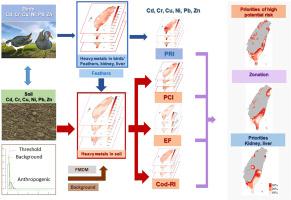Ecotoxicology and Environmental Safety ( IF 6.2 ) Pub Date : 2021-05-31 , DOI: 10.1016/j.ecoenv.2021.112383 Yu-Pin Lin , Johnathen Anthony , Hussnain Mukhtar , Chiao-Ming Lin

|
Geochemical approaches are popular for evaluations based on heavy metal concentrations in sediments or soils for eco-risk assessment. This study proposes a systematic geochemical approach (SymGeo) to explore six heavy metals in topsoils and bird tissues and organs of the target birds. We assume that the proposed approach based on field-collected heavy metals in topsoils and feathers can predict the areas with the potential risk of the heavy metals in birds. Finite mixture distribution modeling (FMDM) was used to identify background values of the heavy metal concentrations in topsoil. A spatial enrichment factor (EF), potential contamination index (PCI), contamination degree (Cod), and potential ecological risk index (PRI) based on FMDM results for topsoil, and a potential risk index (PRIbird) of heavy metals in the birds, were utilized for systematic prioritization of high eco-risk areas. Using multiple EF, PRI, and Cod results and multiple PRI-based maps of the heavy metals in feathers, we systematically prioritized risk areas where there is a high potential for heavy metal contamination in the birds. Our results indicate that heavy metal concentrations in the feather, liver, and kidney are not spatially cross-autocorrelated but are statistically significantly correlated with some heavy metals in topsoil due to external and internal depositions. Further, multiple EF, Cod, and RI distributions for topsoil, along with the PRI of the feather, showed that adequate coverages for potential risk for birds were greater than 71.05% in the top 30% and 84.69% in the top 20% potential eco-risk priority area of heavy metals in bird liver and kidney. Hence, our proposed approach suggests that assessments of heavy metals in bird feathers and topsoils without bird organs can be utilized to identify spatially high-risk areas. The proposed approach could be improved by incorporating water and sediment samples to enhance the crowdsourcing and the species-specific data.
中文翻译:

一种识别土壤和鸟类中重金属潜在生态风险分布的空间优先级方法
地球化学方法普遍用于基于沉积物或土壤中的重金属浓度进行生态风险评估。本研究提出了一种系统的地球化学方法(SymGeo)来探索目标鸟类表土和鸟类组织器官中的六种重金属。我们假设所提出的基于现场收集的表土和羽毛中的重金属的方法可以预测鸟类重金属潜在风险的区域。有限混合分布模型 (FMDM) 用于识别表土中重金属浓度的背景值。基于表土 FMDM 结果的空间富集因子 (EF)、潜在污染指数 (PCI)、污染程度 (Cod) 和潜在生态风险指数 (PRI),以及潜在风险指数 (PRI Bird) 鸟类中的重金属,被用于高生态风险区域的系统优先排序。使用多个 EF、PRI 和 Cod 结果以及多个基于 PRI 的羽毛中重金属地图,我们系统地优先考虑了鸟类中重金属污染可能性高的风险区域。我们的结果表明,羽毛、肝脏和肾脏中的重金属浓度在空间上没有交叉自相关,但由于外部和内部沉积,它们与表土中的某些重金属在统计上显着相关。此外,表土的多个 EF、Cod 和 RI 分布以及羽毛的 PRI 表明,在前 30% 和 84 中,鸟类潜在风险的足够覆盖率大于 71.05%。鸟类肝脏和肾脏中重金属的前 20% 潜在生态风险优先领域中的 69%。因此,我们提出的方法表明,对没有鸟类器官的鸟类羽毛和表土中重金属的评估可用于识别空间高风险区域。可以通过合并水和沉积物样本来改进所提出的方法,以增强众包和特定物种的数据。











































 京公网安备 11010802027423号
京公网安备 11010802027423号